Ground Cover Plants With Yellow Flowers (With Pictures)
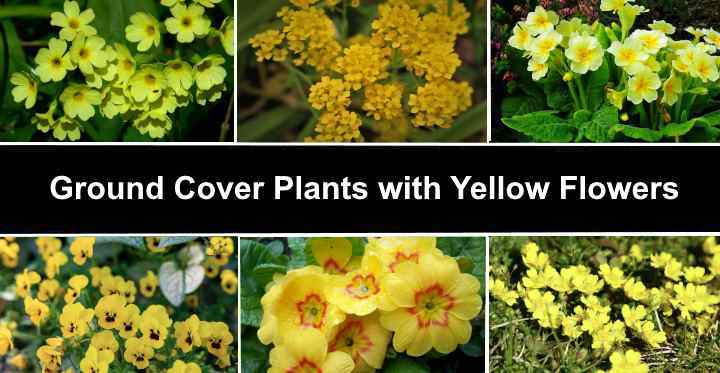
Ground cover plants with yellow flowers are perfect for adding bright golden shades of yellow to a garden landscape. Yellow-flowering, low-growing spreading plants create a brightly-colored carpet of sunshine blossoms. Flowers in vibrant yellow hues typically grow in full sun or partial shade. These mat-forming, creeping yellow flowers can help improve soil consistency, prevent weeds, and stop soil erosion.
Planting ground cover plants with yellow flowers can add a pop of color to a front or backyard. Ground cover plants that thrive in dappled sunlight are ideal as understory plants under trees or large shrubs. Also, full-sun yellow-flowering ground cover plants can be great for planting along a foundation line, in mixed beds, or accenting evergreen shrubs.
The article is an identification guide to the best ground cover plants with yellow flowers. Descriptions and pictures of the yellow blossoms and mat-forming plants will help you choose the best flowers for your landscape.
The Best Ground Cover Plants With Yellow Flowers
Some of the best yellow-flowering plants for ground cover are cinquefoil, creeping buttercup, evening primrose, and yellow stonecrop. These ground-hugging plants fill landscapes with golden yellow and green colors. The spreading perennials typically thrive in full sun or partial shade and don’t grow over 1 ft. (30 cm) tall.
Why Plant Yellow-Flowering Ground Cover Plants
Low-spreading plants with yellow flowers are ideal for brightening a dull garden landscape. The golden yellow, lemon yellow, or canary yellow flowers add bright colors contrasting with green foliage. In addition, mound-forming, creeping, spreading, or trailing plants help to retain soil moisture and inhibit weed growth.
How to Choose Ground Cover Plants With Yellow Flowers
When choosing yellow-flowering ground cover plants, sunlight exposure, soil type, and watering requirements are crucial factors. First, check that the plants are suitable for your USDA growing zone. Then it’s necessary to learn how much maintenance they require. Additionally, some spreading plants could be invasive in some regions.
It’s good to note that some ground cover plants are evergreen in warm climates but grow as perennials in cooler regions. Often referred to as evergreen perennials, the creeping plants will bloom throughout late spring until early fall. However, the foliage may die back when the frost comes before returning the following spring.
Ground Cover Plants With Yellow Flowers (With Pictures) – Identification Guide
Ground cover plants with yellow blossoms have many uses in a garden landscape. Apart from growing the spreading plants to cover bare ground, they can be used along borders, in between paving stones, to trail over fences or walls, or grow in hanging baskets.
Cinquefoil (Potentilla)
Cinquefoil is a group of low-growing, mat-forming plants with dainty golden yellow flowers and tiny green leaves. Many species of these herbaceous perennials are creeping shrubs with trailing stems and yellow flowers growing on erect shoots. Spreading cinquefoil plants thrive best in full sun in USDA zones 3 through 7.
Also called five fingers, silverweed, or barren strawberry, cinquefoil typically are low-growing shrubby plants. Although yellow is the most common blossom color, the plants can also bloom with white, pale pink, or red flowers.
Here are two varieties of cinquefoil that have yellow flowers and a creeping habit:
Creeping cinquefoil (Potentilla reptans): This yellow-flowering creeping perennial has trailing stems and masses of small five-petaled flowers measuring 0.8” (2 cm) across. The plant has vigorous growth and spreads by taproots and runners. It can become an invasive yellow weed in lawns and flower beds. Creeping cinquefoil grows 4” to 6” (10 to 15 cm) tall and up to 40” (100 cm) wide.
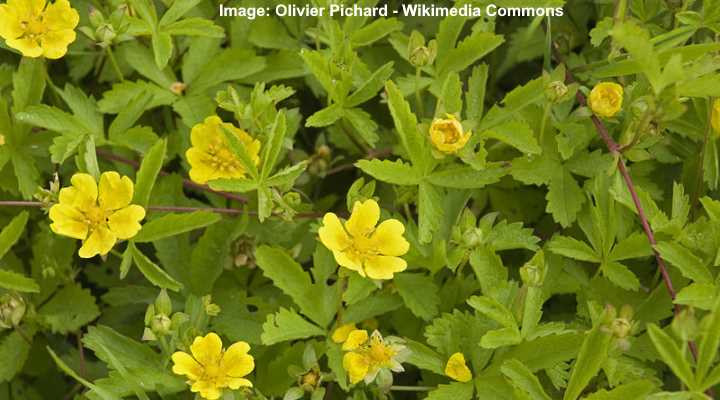
Creeping cinquefoil (Potentilla reptans)
Spring cinquefoil / spotted cinquefoil (Potentilla neumanniana): This mat-forming cinquefoil variety has vigorous growth, abundant small buttery-yellow flowers, and deep green palmate leaves. The early spring blooming ground cover plant grows up to 6” (15 cm) tall.
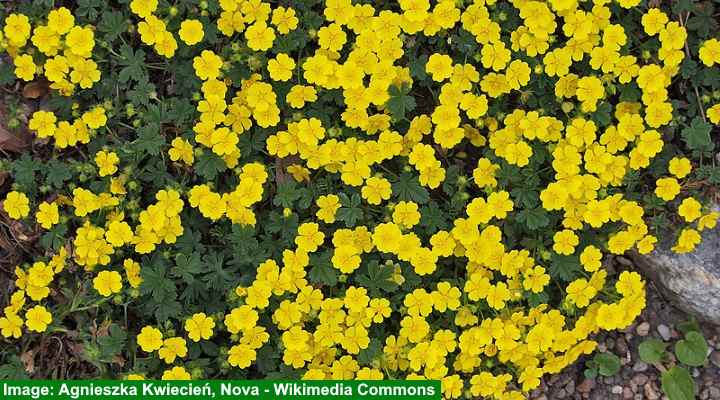
Spring cinquefoil / spotted cinquefoil (Potentilla neumanniana)
Basket of Gold / Golden Alyssum (Aurinia saxatilis, Alyssum saxatile)
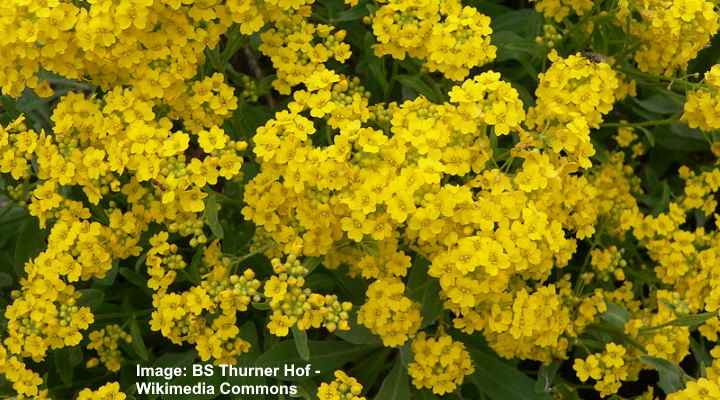
Golden alyssum is an evergreen perennial yellow flowering ground cover plant for full sun
Basket of gold is an eye-catching mounding evergreen perennial with masses of brightly-colored yellow flowers. The golden yellow flowers bloom in spring and last for six weeks. This drought-tolerant charming ground cover plant has grayish-green foliage that contrasts nicely with the yellow flowers. The low-growing plant grows up to 1 ft. (30 cm) tall.
Also called golden alyssum, the mat-forming plant thrives in USDA zones 3 to 7. It’s ideal for planting at the front of beds and borders, along a foundation line, or as ground cover in full sun. It also looks stunning growing alongside ground cover plants with red, purple, or white flowers.
Creeping Jenny (Lysimachia nummularia)
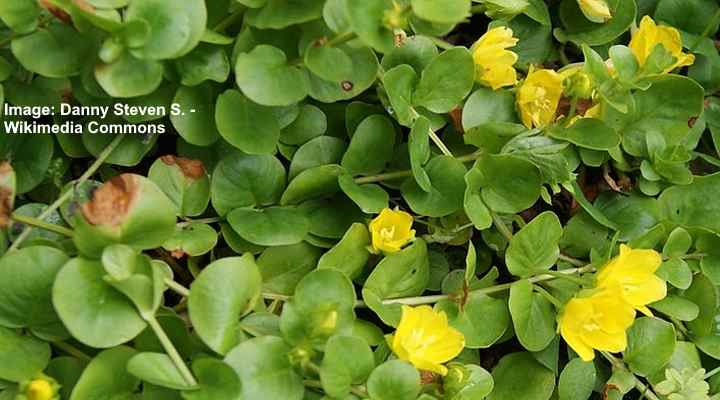
Creeping Jenny is a low growing ground cover plant with yellow flowers for full sun or part shade
Creeping Jenny is a low-growing spreading plant with summer blooming bright yellow, cup-shaped flowers. This evergreen perennial is characterized by its long, trailing stems covered in small heart-shaped leaves. The foliage is chartreuse to bright green which compliments the color of the golden yellow flowers.
Creeping Jenny grows 3” to 6” (7 – 15 cm) tall and up to 18” (45 cm) wide. Thriving in full sun or part shade, the yellow-flowering ground cover plant performs best in USDA zones 3 to 9.
Golden creeping Jenny has vigorous growth and quickly covers bare ground. The trailing green and yellow stems also work well when trailing over fences, dangling from hanging baskets, or growing along borders.
Creeping Buttercup (Ranunculus repens)
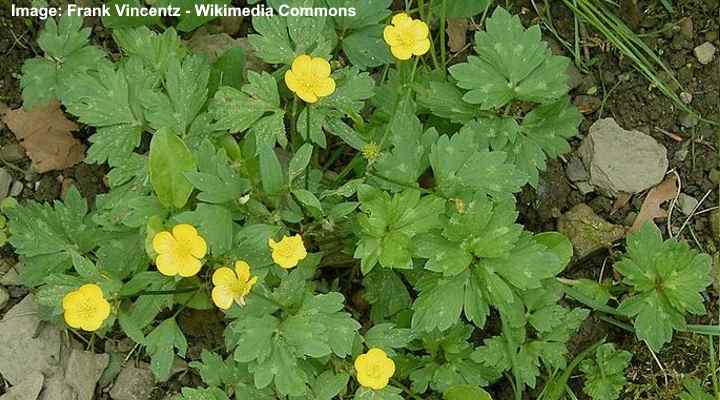
Creeping buttercup is a fast growing ground cover plant for full sun with small yellow flowers
Creeping buttercup is a yellow-flowering perennial with prostrate stems, deeply lobed leaves, and small five-petaled yellow flowers on erect stems. Creeping buttercup spreads via rooting stolons where it grows 12” (30 cm) tall and up to 3 ft. (1 m) wide. The fast-growing ground cover plant performs well in damp places.
Also called creeping crowfoot, the ground cover plant with yellow flowers thrives in full sun in USDA zones 4 to 9.
Creeping buttercup grows well in most temperate regions and will grow where turfgrass can’t. However, its vigorous growth means that the spreading can be invasive in some areas. Some gardeners consider creeping buttercup a type of flowering weed.
Stonecrop (Sedum)
Many varieties of stonecrop are mat-forming, creeping plants with clusters of small yellow flowers. The easy-to-grow flowering plants are ideal for garden landscapes as they have a long blooming season, survive well in poor soil, and require little maintenance. Additionally, because they are succulents, the stonecrop generally performs well in droughts.
Here are some of the best stonecrop plants with yellow flowers, suitable for ground cover in sunny conditions:
Reflexed stonecrop stonecrop (Sedum rupestre, Sedum reflexum): This evergreen perennial is a low-growing, mat-forming plant with masses of yellow star-shaped flowers. The brightly-colored flowers compliment the green-gray needle-like leaves. Angelina stonecrop grows 4” to 6” (10 to 15 cm) tall and up to 24” (60 cm) wide.
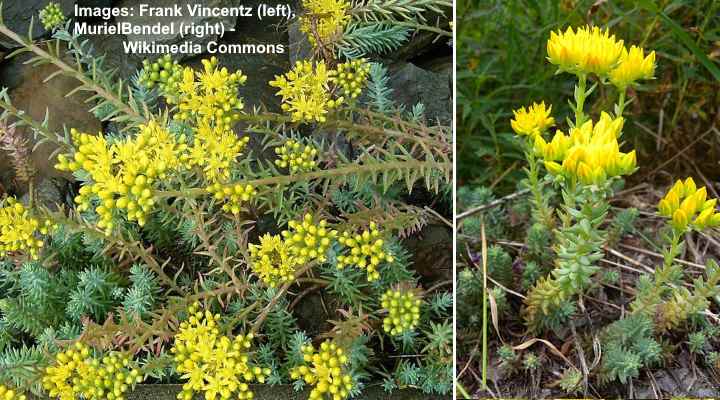
Reflexed stonecrop (Sedum rupestre, Sedum reflexum)
Gold moss stonecrop (Sedum acre): This low-growing drought-tolerant succulent creates a carpet of bright yellow star-shaped flowers. The quickly spreading ground cover also features green conical leaves. The creeping plant thrives in most soil types and is suitable for a lawn substitute, hanging basket plant, or accent evergreen shrubs.
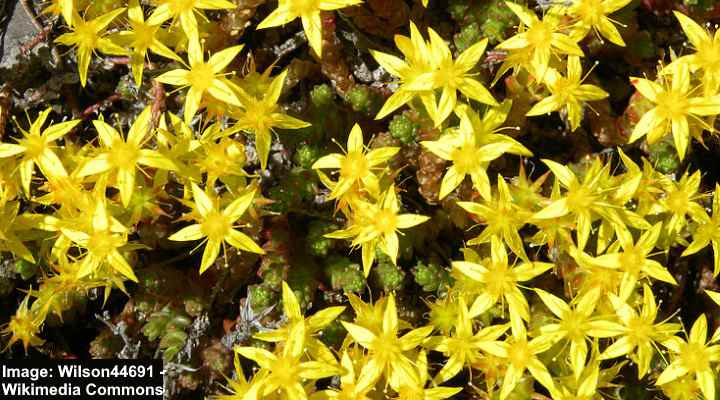
Gold moss stonecrop (Sedum acre)
Stringy stonecrop (Sedum sarmentosum): As a mat-forming succulent, this sedum variety blooms with masses of yellow, star-shaped flowers and has thick, fleshy, yellowish-green lanceolate leaves. Stringy stonecrop stems grow up to 10” (25 cm) long.
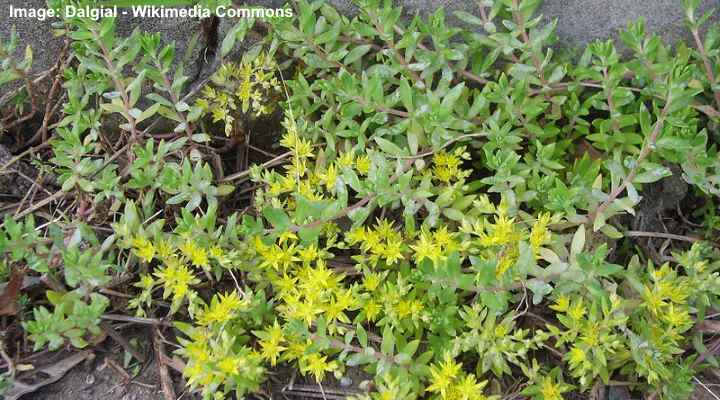
Stringy stonecrop (Sedum sarmentosum)
Yellow stonecrop (Sedum nuttallii): This yellow-flowering ground cover plant has yellowish-green fleshy leaves and small yellow flowers growing on horizontal branches. The mat-forming succulent grows in clumps and can spread several feet in diameter.
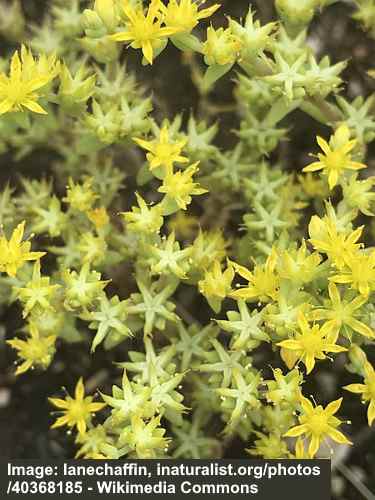
Yellow stonecrop (Sedum nuttallii)
Yellow Trailing Ice plant (Lampranthus spectabilis)
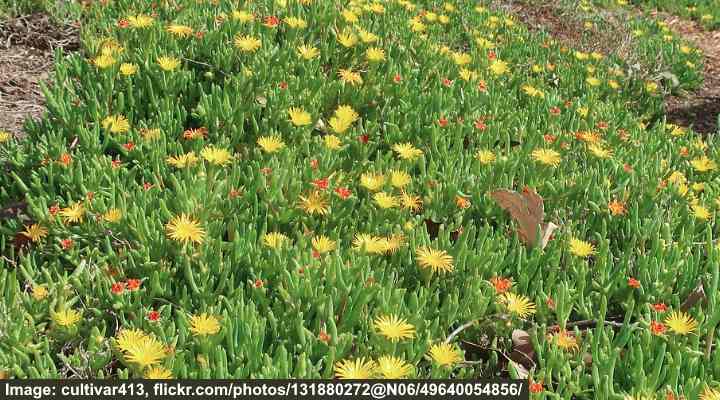
The yellow ice plant is a trailing ground cover flowering succulent for full sun
Yellow ice plant is a trailing perennial with an abundance of yellow daisy-like flowers. The yellow flowers consist of long, slender petals fanning out from a central yellow center. The disc-shaped yellow flower heads bloom from late winter until early spring in warm winter locations, or in summer to fall in cooler zones.
Evergreen yellow ice plants thrive in USDA zones 8 through 10. The spreading tender perennial features bluish-green finger-like leaves growing on wiry stems.
Yellow ice plant grows 6” to 12” (15 – 30 cm) tall and spreads up to 26” (65 cm) wide. The yellow-flowering ground cover plant is ideal for growing in rock gardens, ground cover in full sun, border fronts, or containers. They also make excellent hanging basket flowers where the ornamental flowering stems cascade over the side.
Barren Strawberry (Waldsteinia fragarioides)
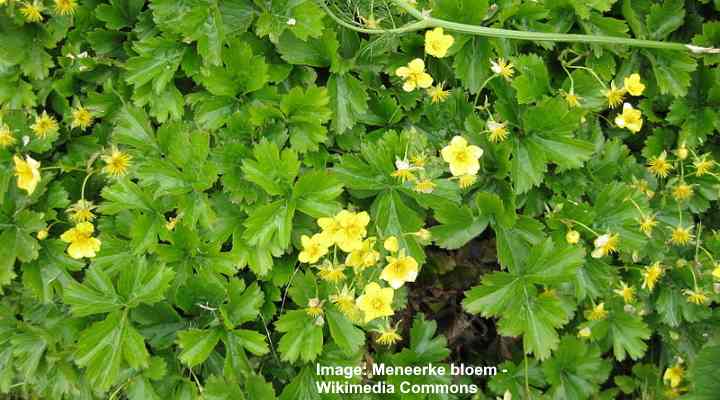
Barren strawberry is a yellow flowering perennial ground cover that is low maintenance and easy to care for
Barren strawberry is a ground-hugging spreading plant with small golden yellow flowers consisting of five petals. This attractive evergreen perennial plant also has trifoliate, wedge-shaped leaves. The sun-loving plant forms a mat of yellow flowers and deep green foliage. It grows 3” to 6” (7 – 15 cm) tall and up to 12” (30 cm) wide.
Barren strawberry gets its name from its growth habit — prostrate along the ground like strawberry plants. The mat-forming plant creates attractive ground cover along pathways, borders, or rock gardens. It performs well in USDA zones 4 through 7.
Partridge Feather Plant (Tanacetum densum ssp. amani)
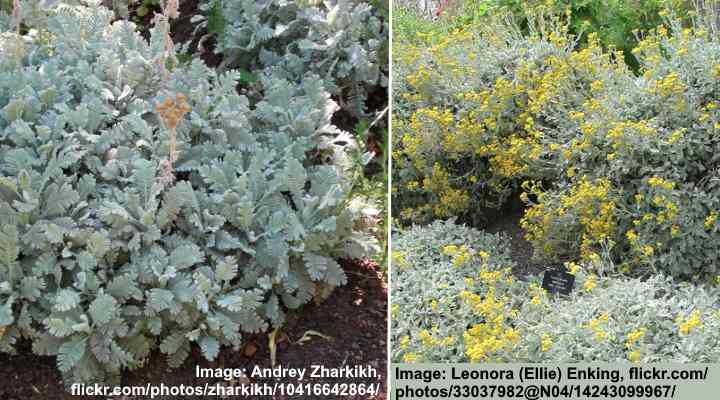
Partridge feather plant is an attractive ground cover with gray leaves and small yellow flowers that thrive in dry areas
Partridge feather plants are identified by their silvery-gray foliage, golden yellow flowers, and clumping, spreading nature. The tiny button-like yellow flowers grow in small clusters on the ends of stems. It has unusually feathery leaves that create a mat of silver shades growing 6” (15 cm) tall and 24” (60 cm) wide.
Partridge feather plants perform best in dry conditions and are ideal for landscaping xeric garden landscapes. The sun-loving spreading plant grows well in loamy, sandy soils and is tolerant of drought once established. It’s suitable for growing in USDA zones 4 through 9.
Yellow Archangel (Lamium galeobdolon)
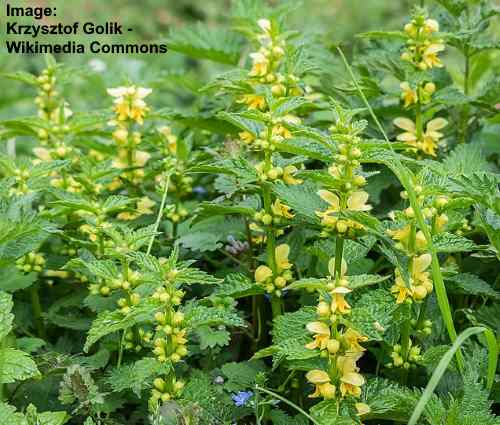
Yellow archangel is a shade tolerant perennial ground cover with yellow flowers growing on stalks
Also called golden dead-nettle, yellow archangel is a spreading perennial with small tubular yellow flowers. The dainty golden yellow flowers bloom on short stalks appearing from creeping runners in late spring. The sprawling, vine-like flowering plant has aromatic, dark green leaves that are ovate with serrated margins.
Yellow archangel plants can spread indefinitely via underground stolons. Because it’s tolerant of shade, yellow archangel is ideal for ground cover in shaded gardens or wooded areas. You can grow this trailing perennial flower in USDA zones 4 to 8.
Perennial Peanut (Arachis glabrata)
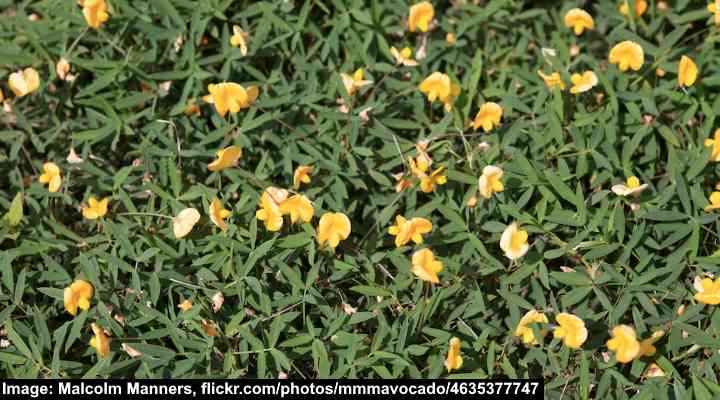
Perennial peanut is a ground cover tender perennial for full sun that is also drought tolerant
Perennial peanut is a summer-blooming low-growing plant with tiny yellow flowers. The spreading plant is related to legumes and is typically used in agriculture for erosion control and stabilizing soil. It also has ornamental value, making it ideal for fast-growing ground cover in sunny residential gardens.
Hardy to USDA zones 8 – 11.
Evening Primrose (Oenothera)
Most species of evening primrose plants have yellow flowers, and many varieties have a low-growing, spreading habit. The plant gets its name from the way the yellow flowers of many species open in the evening. Despite its name, Oenothera isn’t related to true primrose plants.
Here are two varieties of yellow evening primrose suitable for ground cover:
Common evening primrose (Oenothera biennis): This spreading plant features beautiful bowl-shaped yellow flowers that emit a lemon scent. The biennial plant blooms profusely from early summer through early fall. The drought-tolerant, self-seeding plant grows 3 to 5 ft. (1 – 1.5 m) tall.
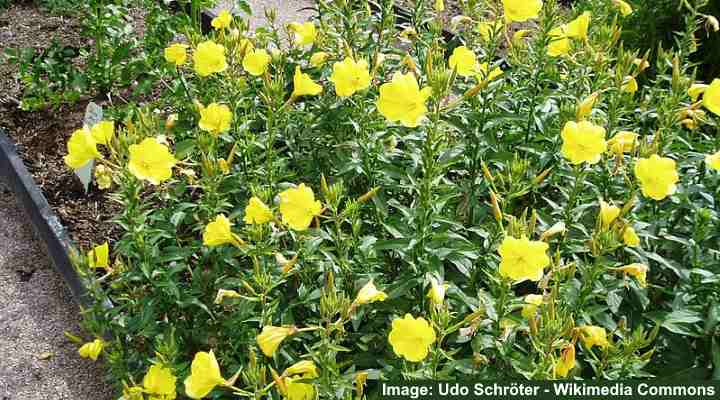
Common evening primrose (Oenothera biennis)
Narrowleaf evening primrose (Oenothera fruticosa): This low-growing evening primrose plant is identified by its showy bright yellow flowers in an open saucer shape. Also called sundrops, these large yellow flowers grow at the ends of reddish stems surrounded by lanceolate leaves.
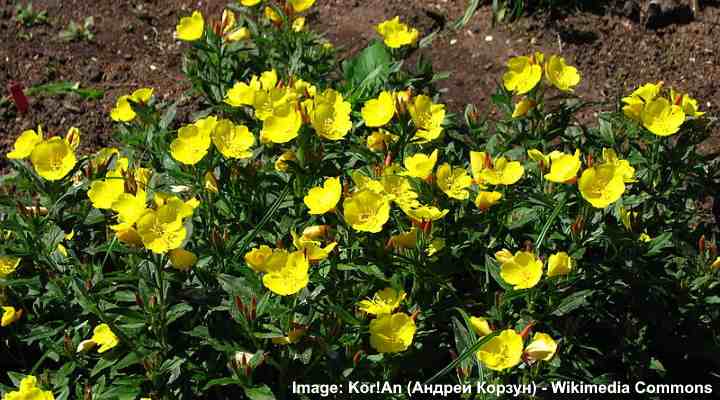
Narrowleaf evening primrose (Oenothera fruticosa)
Primrose (Primula)
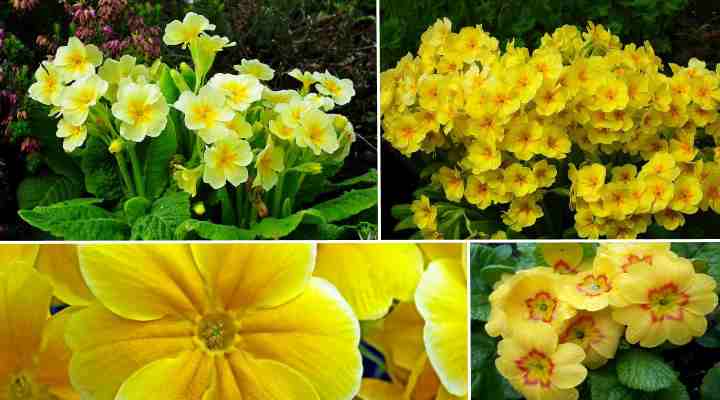
Primrose plants include many cultivars with yellow single or double blooms that can be used as a low growing ground cover in partly shaded areas
Primrose plants are typically clumping, low-growing plants, many of which have showy yellow flowers. The showy ornamental flowers bloom for several weeks and form small clusters of golden yellow single or double blooms. In addition, some primrose species have striking multicolored petals in contrasting yellow, red, black, and purple colors.
Here are a few primrose varieties with yellow flowers and a spreading habit:
Common primrose or English primrose (Primula vulgaris): Also called wild primrose, this low-growing variety has pale creamy-yellow flowers with a darker yellow center. The yellow-flowering plant grows 6” (15 cm) tall and 9” (22 cm) wide.
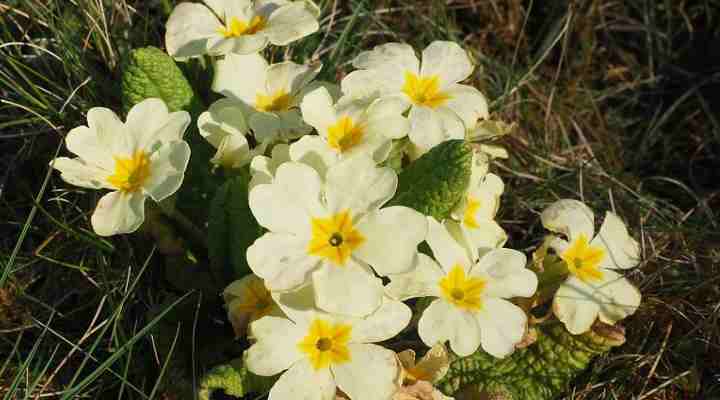
Common primrose or English primrose (Primula vulgaris)
Cowslip (Primula veris): Suitable for growing in part shade, cowslip has drooping funnel-shaped lemon-yellow flowers. The delicate flowers bloom among oval to lance-shaped fuzzy green leaves.
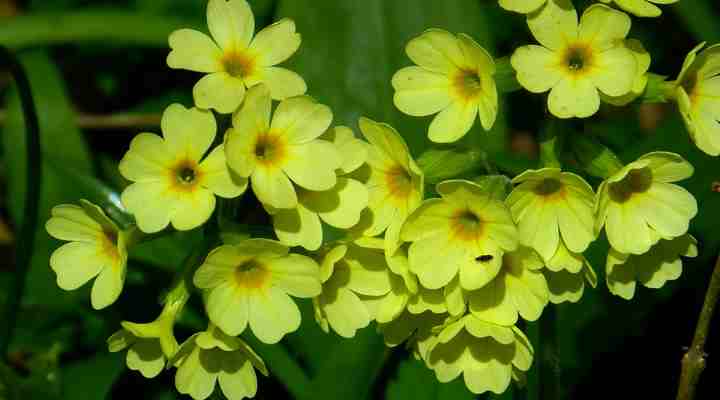
Cowslip (Primula veris)
Primula Belarina Buttercup: The outstanding feature of Belarina buttercup primrose flowers is their large, brightly yellow-colored double flowers growing at the end of sturdy stems. The low-growing plants are perfect for revitalizing borders, beds, and containers.
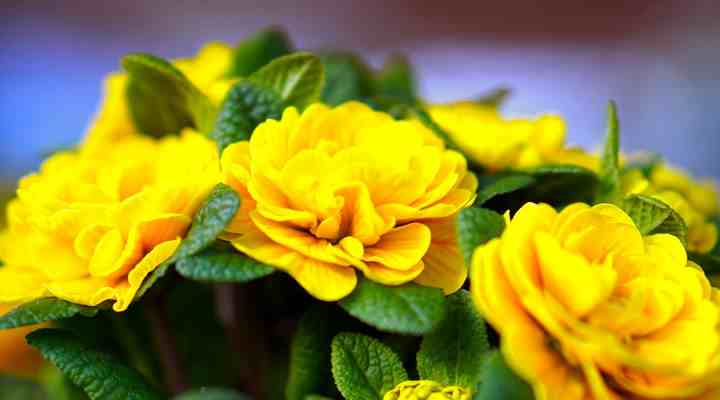
Primula Belarina Buttercup
Primula ‘Barnhaven Gold’: Barnhaven gold primroses have dainty flowers with a deep yellow color and darker yellow-orange centers. The shade-loving plants grow 4” to 6” (10 – 15 cm) tall and grow well as understory flowers to brighten up shaded areas.
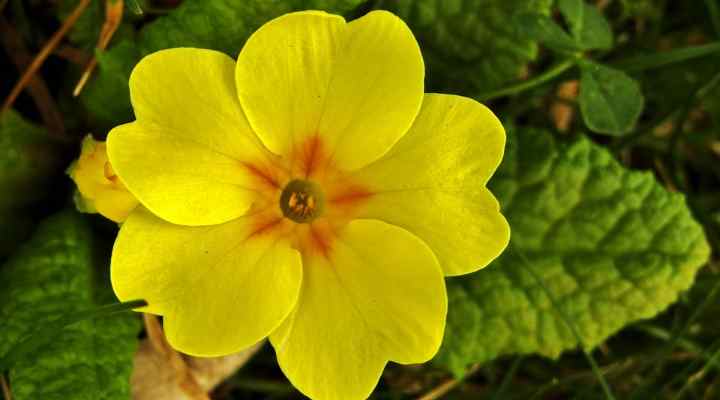
Primula ‘Barnhaven Gold
Woolly Yarrow (Achillea tomentosa)

Woolly yarrow is a sun loving yellow flowering ground cover perennial
Woolly yarrow is a low-growing semi-evergreen perennial with golden yellow flowers growing in dense clusters called corymbs. The eye-catching flowers bloom in spring and summer and contrast with green-gray foliage. The yellow-flowering ground cover plant grows up to 8” (20 cm) tall and 45” (114 cm) wide.
Woolly yarrow thrives in cooler climates in USDA zones 3 to 7 in full sun. The yellow flowers of this spreading plant are ideal for ground cover, brightening up borders, landscaping pathways, or growing in containers.
Upright Wild Ginger (Saruma henryi)
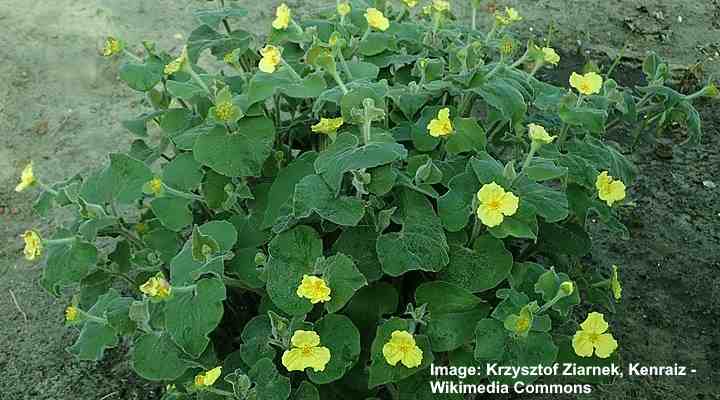
The yellow flowering upright wild ginger is suitable as a ground cover plant for shaded areas
Upright wild ginger is a clumping, shade-loving ground cover plant with yellowish-green three-petaled flowers. The delicate ruffled chartreuse flowers grow 1” wide and bloom in spring through summer. The slow-growing mounding plant grows 24” (60 cm) tall and 39” (100 cm) wide.
Upright wild ginger is suitable for ground cover in part shade to full shade in USDA zones 5 – 8. The spreading herbaceous perennial creates a carpet of fuzzy foliage consisting of heart-shaped green leaves. When in bloom, small yellowish flowers speckle the green mat.
Horned Pansy (Viola Cornuta)
Horned violets (also called horned pansies) are planted en masse as bedding plants to cover bare ground. The spectacular flowering perennials or annuals typically have a low-growing, clump-forming habit decorated with two-toned blooms. Many violets have cultivars with pale yellow to deep yellow-orange colors. The flowering plants can create eye-catching floral displays.
Horned pansies are perennials that can be grown as annuals. They are typically hardy outdoors in USDA zones 6 through 11. The spreading, creeping plants grow 9” (22 cm) tall and 12” (30 cm) wide.
Here are some examples of yellow-flowering pansies you can use as ground cover in full sun or partial shade:
Viola cornuta ‘Sorbet Yellow Delight’: Golden yellow rounded petals with dark brown veins in the yellow center.
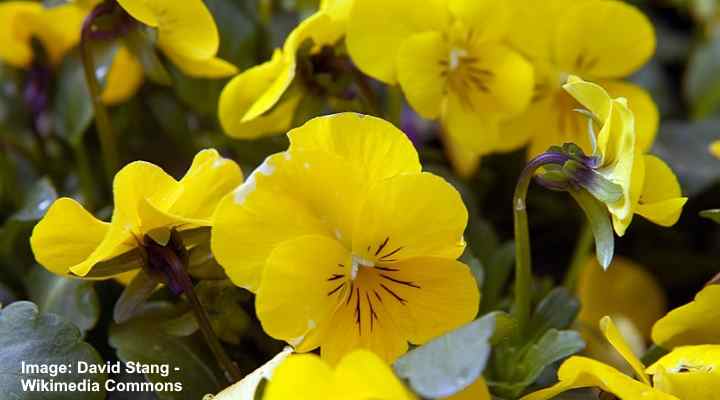
Viola cornuta ‘Sorbet Yellow Delight’
Viola cornuta ‘Twix Yellow Red Wing’: The stunning low-growing plant has flowers with contrasting yellow and deep purple or maroon petals.
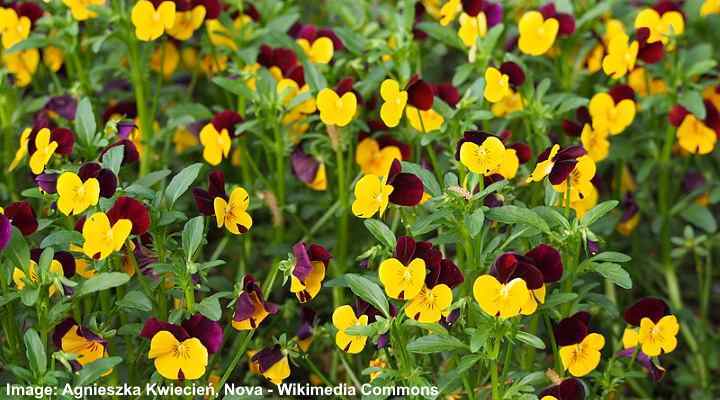
Viola cornuta ‘Twix Yellow Red Wing’
Viola cornuta ‘Sorbet Lemon Chiffon’: This violet cultivar has pale yellow heart-shaped petals and dark reddish-brown twig-like veins in the center.

Viola cornuta Sorbet Lemon Chiffon
Viola cornuta ‘Callisto’: Unlike most pansies, this brightly-colored flower has pure yellow petals without contrasting colors.
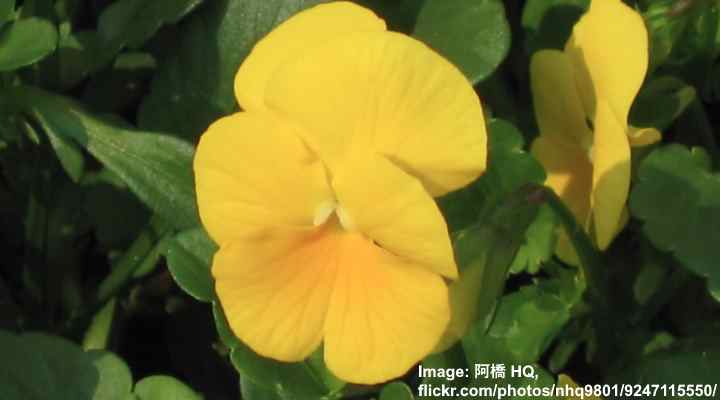
Viola cornuta Callisto
Related articles:
